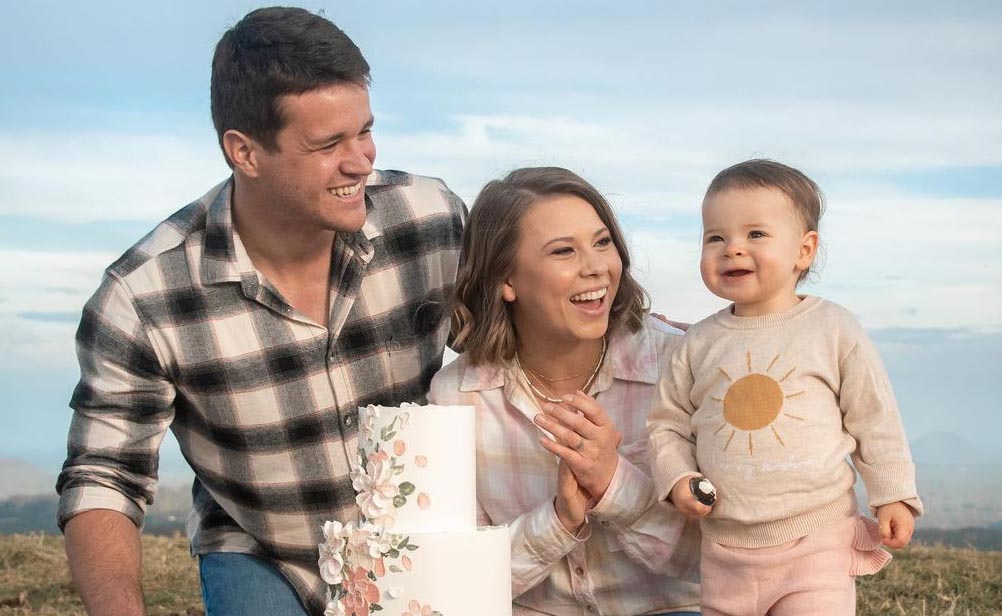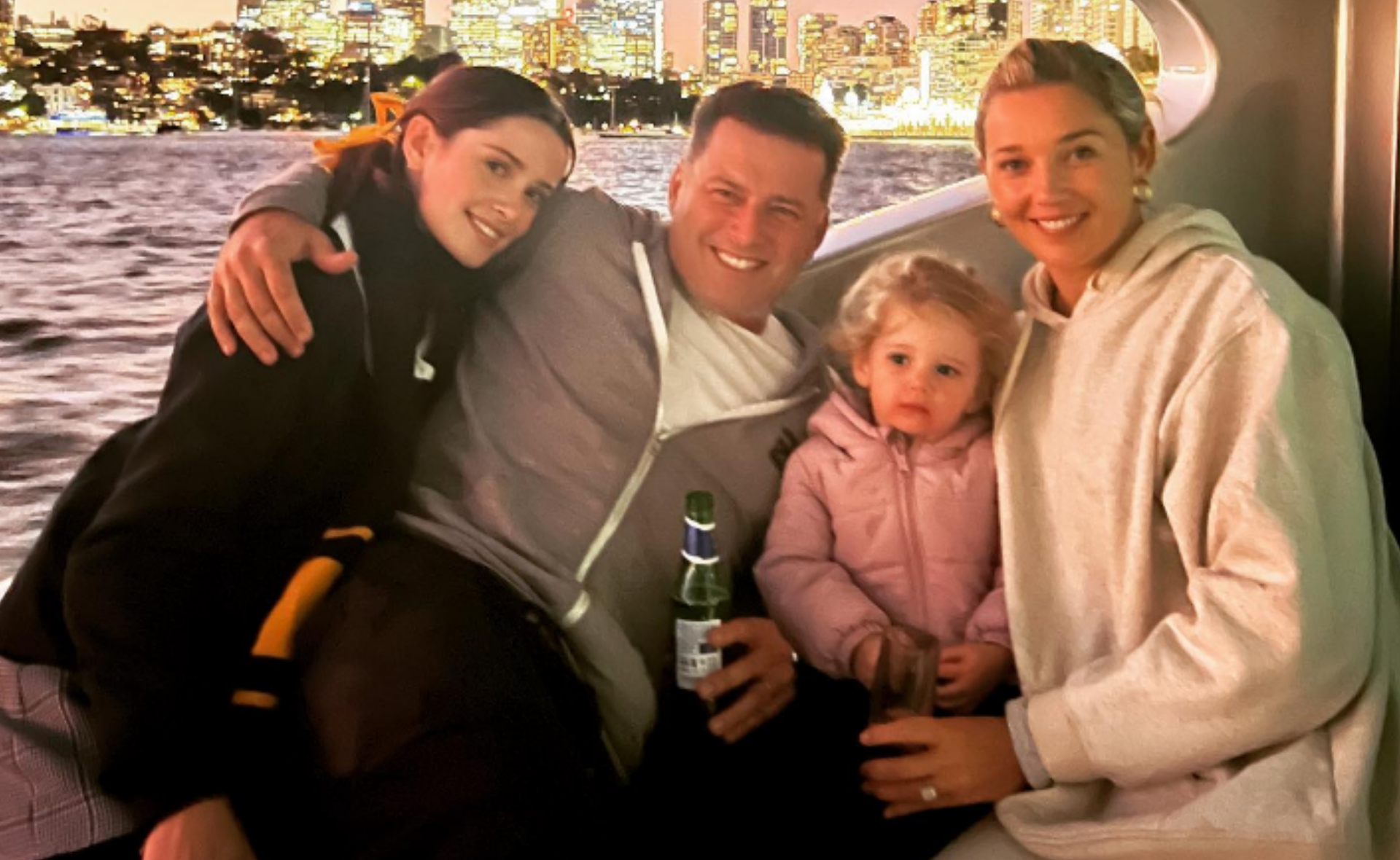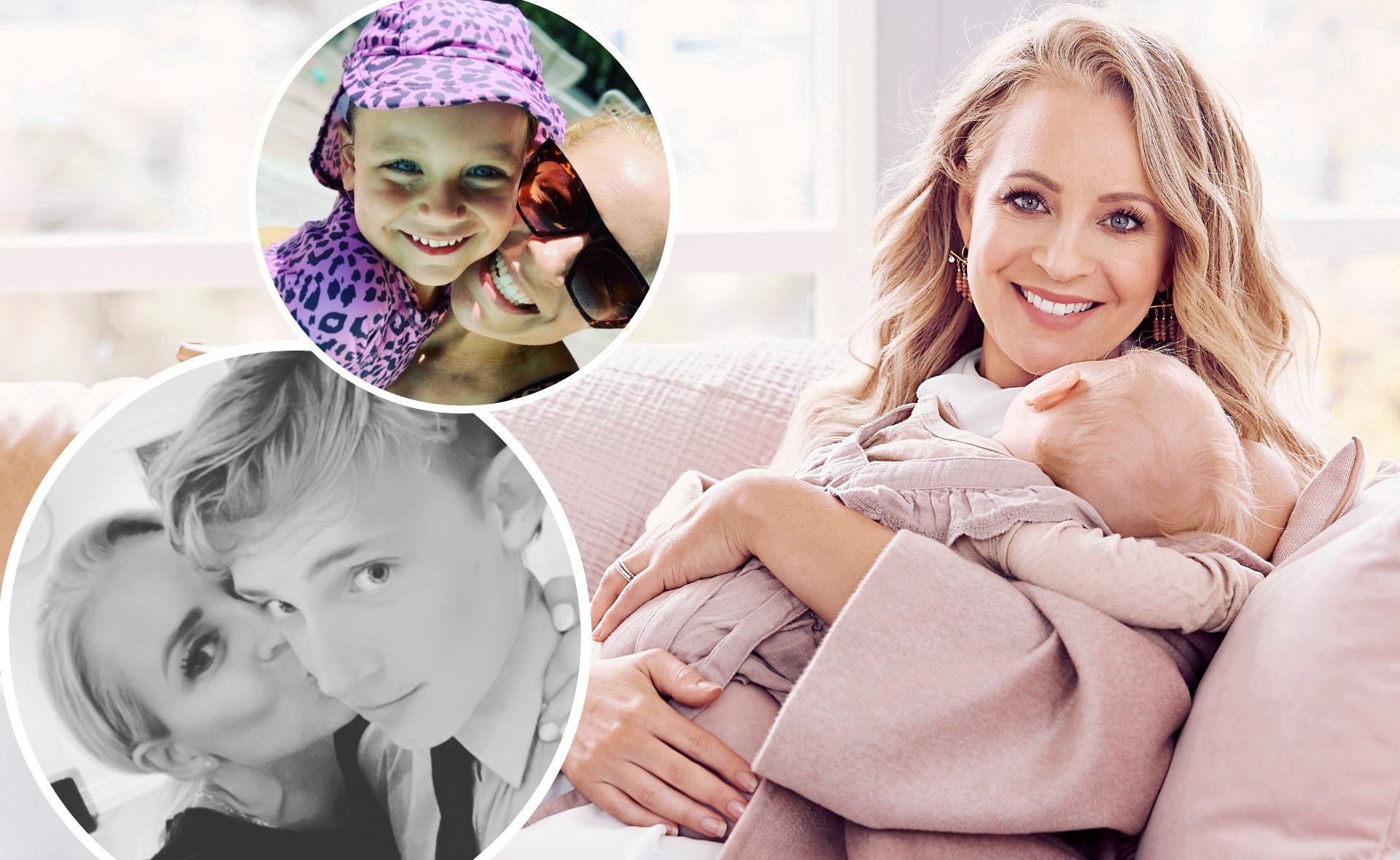With her arms wrapped around baby Lachlan, the ABC’s dynamic disability news reporter Nas Campanella is engrossed in the ubiquitous mum dance – pacing softly around the living room, gently rocking her son as she whispers in his ear.
Sleep, she hopes, will follow.
Lachie is snuggling in, a vision of newborn contentment, as his dad, fellow ABC journalist Thomas Oriti, watches on with pride and wonder.
Every day is an adventure for the tight-knit trio and as Nas passes the almost three-month-old over to Tom, she strokes her baby’s cheek and he lets out a sweet sigh.
“Everyone says he looks like Tom. He’s all Dad, they say. For me [I see] incredibly chubby cheeks. Very chunky gorgeous thighs. A beautiful tiny little nose and plenty of hair,” she says, describing baby Lachlan to a tee.
“And his skin feels incredible. It’s so smooth and when we give him a bath every night, we always do tummy time when I use moisturiser on his skin; that’s also a way of me making sure that he doesn’t have any rashes on him. The moment I feel a change in his skin, that’s how I will know that there’s something we need to tend to.”
Nas, 33, lost her sight when she was six months old.
“The blood vessels burst in the back of my eyes,” she explains, her matter-of-fact tone a testament to how regularly she has to explain her condition. “There’s really no explanation of why or how it happened. It’s just listed as ‘rare retinal abnormality’,” she adds.

Nas, her husband Tom and baby Lachlan
(Photo: Alana Landsberry)Nas’s younger brother, Ben, also has the condition, so it’s undoubtedly genetic and in his case, doctors managed to restore some sight.
“Ben was born four years after me and it’s pretty incredible how quickly science advances. Ben is legally blind, but uses glasses so he can see things that are enlarged and up close. I just see shadows,” notes Nas.
“If I’m walking along a street I’ll be able to notice that there is something I’m walking past, but I won’t know whether it’s a tree, a person, an electricity box or whatever unless I touch it. I also don’t know if it’s light or dark unless I can feel the sun on my face. Time of day is more of a feeling for me. The birds sound different in the night and the day. If it’s really quiet, particularly along the busy road we live on, I know it’s early morning.”
Nas spent her childhood in and out of hospitals as doctors tried everything to restore her sight.
“I spent years having surgeries, most of them experimental procedures. It was fairly traumatic, to be honest. Those early years for me are vivid memories of being in hospital. It was only in my mid-teens, after saying to my parents, ‘I don’t want to do this anymore. I’m not concerned with restoring my sight. I’m very happy with who I am’ that it stopped. I was at school and doing extra-curricular activities and I think they could see that it really didn’t matter. I was thriving.”
Medical treadmill aside, carpenter Frank Campanella and his wife, Tonya, who worked in admin, deliberately strove to give their daughter as normal a childhood as possible.
“I grew up in Sydney’s western suburbs in a big, loud Italian family,” says Nas smiling. “I’m one of 12 grandchildren and Lachie is the 20th great-grandchild. I’ve got one grandmother left, Mum’s mum, who I’m incredibly close to. She looked after my brother and me and would pick us up from school and give us afternoon tea of homemade pasta or pizza.”

Nas spent her own childhood in and out of hospital, something she struggled with.
(Photo: Alana Landsberry)In the family dynamic, Nas was expected to play her part and if anything, there was a stronger emphasis not to wrap her in cotton wool.
“If we went out on a family picnic and we were all making food to take then I was expected to be in the kitchen doing it as well. Mum wanted me to be independent. I had occupational therapy sessions from a very early age to make sure I could identify all the clothing in my wardrobe and could get dressed myself. I could brush my own hair. I could put a load of washing on. I could make myself a meal. This meant when I left home, I didn’t need to rely on other people. I also had a cane instructor so that I could learn how to get from A to B on my own.”
And when she started high school, Nas took the bus with the other kids.
“Mum was terrified about it and I remember the first time, she actually drove behind the bus, which was so embarrassing. I didn’t know she’d done it until I got off at the bus stop and she was there.”
Nas first attended St Lucy’s School for the blind, but at age seven transitioned to the mainstream.
“I think people with disabilities should be in mainstream in every aspect of life; if not, for me that’s a form of segregation.”
For the other students Nas was a novelty, but her chutzpah shone through.
“Of course, there were times when children would say things like, ‘How many fingers am I holding up?’. But I was an outspoken young girl and would just tell them where to go.”
Making friends was easy.
“I was confident enough to just insert myself into a group,” she says, but that feeling of being different was harder to brush off. “I wanted to fit in, to be like everybody else. I didn’t ever want to use my cane. I knew people would stare at me and I hated it!”
But even though she loved the social side of school, Nas was struggling academically.
“I couldn’t make out the Braille dots on the page and I was really falling behind,” she recalls.
Then, at the age of 10, she was diagnosed with Charcot-Marie-Tooth, a genetic disease unrelated to her blindness which causes lack of sensitivity in the fingertips.
“It was a huge relief because I felt I was stupid. Finally getting this diagnosis meant that we could make plans. I was no longer going to learn via Braille and we introduced audio technology.”
Post-diagnosis, Nas came on in leaps and bounds.
She started working in community radio which she loved and studied hard for her HSC, winning a place at the University of Technology in Sydney to study journalism. When she applied for jobs, Nas deliberately wouldn’t tell them about her disability.
“There was no need to disclose it. I had a portfolio of work, a very good CV and great references from all the internships I had done. I felt confident in what I could bring to the workplace.”

Nas loved working in community radio and went on to study journalism
(Photo: Alana Landsberry)It was the sort of feisty move that has fuelled Nas’s success, but while she was regularly invited for interviews, the response from potential employers was dispiriting.
“Often they would say things like, ‘We don’t have a safe enough workplace for someone like you’. Or ‘How can you be a journalist when you can’t see?’. When I walked in with a cane, they had already made up their minds.”
How did she rise above it?
“You go home, have a cry, feel sorry for yourself for five minutes and then you get over it and think, ‘I’m going to make this happen’.”
For Nas, that moment came when at the age of 22 she beat hundreds of applicants for a cadetship with the ABC.
She spent her first year in the Sydney newsroom and so impressed her bosses that she was offered a full-time contract to stay in the flagship HQ, something that rarely happens.
But Nas was determined to complete her training.
“All the other cadets do a regional placement and I wanted that same experience. Six hours away from anyone I knew and living in a little place all on my own, with next to no public transport, fending for myself, that’s what I wanted.”

Nas met her husband Tom during a regional placement in Bega
(Photo: Alana Landsberry)Nas was posted to Bega where she met Tom, who’d already been there for two years. Nas was actually sent to replace him.
“Mum stayed with me for the first week to help me set up and Tom came for dinner every night because he’d offered to drive me home so I didn’t have to walk on my own. Mum, the hospitable Italian mama, would say, ‘Come in for dinner’. It was this hilarious thing,” remembers Nas.
Almost immediately romance sparked.
“Nas was funny,” says Tom. “We had very common interests, were from similar parts of Sydney and both from Italian backgrounds.”
“I remember we went out for dinner one night and chatted for hours and hours, about anything and everything. Tom’s incredibly intelligent and I loved that about him,” says Nas.
“I was never a believer in love at first sight but it was almost instantaneous. She was the one,” says Tom.
They continued a long-distance relationship and later moved in together.
“When you live with Nas and see the way she goes about her daily life, it doesn’t take long for you to realise that nothing’s beyond her,” he beams.
Tom planned his wedding proposal carefully.
“It was on a rock looking over the ocean where we always used to sit. I remember being quite agitated because I was trying to present this ring to her before we got drenched by a storm coming off the ocean.”
Tom had the engagement ring custom-made.
“Nas loves fashion, and the best fashion for Nas when it comes to clothing or jewellery is it’s got to be tactile, so she can feel it. The ring is an elevated pear-shaped diamond with pink diamonds on either side also elevated in bezels on a white-gold band.”
It was an instant yes from Nas.
“Planning the wedding was fun, to go off to a designer with Mum and feel fabric and talk about colours. The dress was pink. I didn’t want white. White for me is a colour that reminds me of hospital,” says Nas.
Two years before their wedding in a one-off acting role, she had played a pregnant woman who was blind in Channel 10’s Offspring. For the first time it made her think about her own plans for motherhood.
“When the baby was placed on my chest in the show, it was confirmed the child wasn’t blind like her mum. There I was, playing a mother, elated her daughter wasn’t born with the same disability as her,” says Nas.
“On the way home I felt overwhelmed. I kept thinking that could be me one day. I burst into tears, but I didn’t know why. Early on Tom and I had talked about having children and obviously, we had the discussion about the fact that our child may inherit my conditions. It never, ever was an issue for Tom. He was very clear that it just didn’t matter. And at that moment I think it was my own internal able-ism that made me slightly worry.
“You see it’s not the disability that’s the problem, it’s the world around us that isn’t accessible or inclusive. I have grown up in a world that wasn’t made for me or other people with a disability. We often turn up to buildings that aren’t accessible or face prejudice from people. I was worried that if our child did have a disability they would face those same inequities, prejudices and discrimination. I didn’t want that for them.
“But I also know that society is changing, really slowly but it is, and whatever my children are going to have or not have, that wasn’t the issue; it’s everyone else that is the issue. So, we worked out very quickly that we wanted children. I have an amazing life and who better to be a parent to a child with a disability than a person with a disability themselves who can help them navigate that?”
As with everything in her life, Nas approached pregnancy with an abundance of planning.
“We did a lot of research on everything from a doula, to occupational therapists to teach me how to wrap the baby and change nappies. I knew that my neurological condition meant that I needed to make sure my body was ready to not only be pregnant but then to look after a baby. I worked with an exercise physiologist for two years before getting pregnant to make sure I would have enough strength in my arms and legs to be able to get up off the couch while holding a baby.”
Once pregnant, Nas and Tom started working with the medical services in earnest.
“I have been in the medical system since I was six months old and the greatest experience I’ve had by far is having the baby,” says Nas.
“The team had never had a blind mum before, which I found really hard to believe but in a sense that was great because yes, they didn’t know what to do but they wanted to learn. They talked to me about everything.”
Nas did face some medical issues but true to form took it all in her stride.
“I really liked being pregnant. I loved feeling my belly get bigger. I also loved when strangers started to notice my belly. I could sometimes sense people were surprised and for me my belly was a symbol of rebellion, like I was saying to people ‘yes, I am pregnant and I will be an amazing mother despite what you might think’.”
Over the past three months navigating parenthood has proved exciting and emotional and while Nas and Tom are well aware theirs is a world with special challenges, like every other parent, now is their time to learn and feel their way.
“The first night home with him was terrifying; when you’re on your own with this little baby in the house who you’ve got to keep happy and well,” Tom, 35, recalls. “But I would honestly say we are not stressed out parents.”
“The first couple of weeks were really hard. I was recovering from a C-section and in a lot of pain,” says Nas who admits she was tough on herself in those early days.
“I wanted to be an equal, active parent from the moment the baby was born and all of a sudden not being able to pick him up, struggling to get myself out of bed, that meant that I wasn’t being the mum that I wanted to be. I felt like Tom was taking the lion’s share and I didn’t like that. But after my balance settled down, it just fell into place.
“I’d practised so many times changing a nappy on a doll. But then actually doing it on Lachie who wriggles around and who’s heavier was so different. I make sure I’ve always got a hand on him so he doesn’t roll off the change table, and also grab a new nappy, and then I reach for the wipes, his clothes and just figure it out.”
“Watching Nas adjust to motherhood was such a beautiful part of the process and he has really been a dream of a boy,” says Tom.
Outside the house the couple still has to face ignorant prejudice.
“A few weeks ago I was crossing the road and I pushed the traffic light button and someone said, ‘oh wow, you found the traffic light’! I wanted to turn around and say, ‘actually I’m on my way to go and pick up my child and my husband at the cafe and go back to a home that we own and that I helped pay for’. It’s frustrating that those things have always happened to me and always will until society changes.
“Someone actually asked Tom how he feels being mother and father. I had been up every two hours that night feeding Lachie while Tom slept soundly. I was so insulted.”
Tom is continually shocked at other people’s reactions.
“As a mother, apart from driving the baby around, Nas can fulfil every task that any other mother would, disability or not. And yet almost daily people say things like ‘How’s Nas going to cope now you’re back to work?’ ‘How is it being the mother of the house, Tom?’ All of these patronising comments … Nas has met every challenge and every obstacle of motherhood, regardless of her disability.”
Lachie’s progress is right on track and he is a very happy baby.
Tom and Nas don’t know if he may develop her condition, it is a matter of waiting and watching.
“We’re monitoring his vision but it doesn’t matter to me,” says Nas. “So far, as far as we can tell, he can see and if that changes then nothing changes for us. It is what it is.
“Having Lachie is the best thing I’ve ever done. It’s magic. When I feel his cheek against mine, his hand in mine, it’s beautiful.”
You can read this story and many others in the July issue of The Australian Women’s Weekly – on sale now


.jpg)

